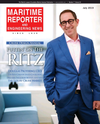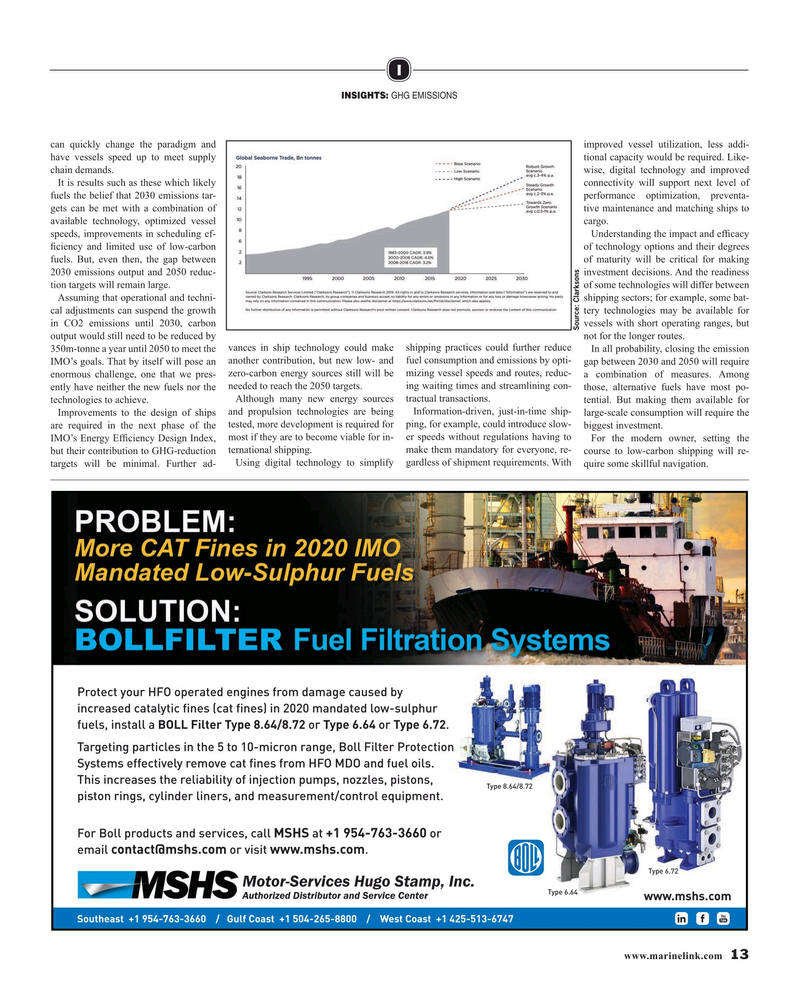
Page 13: of Maritime Reporter Magazine (July 2019)
Cruise Vessel Design & Outfit
Read this page in Pdf, Flash or Html5 edition of July 2019 Maritime Reporter Magazine
I
INSIGHTS: GHG EMISSIONS can quickly change the paradigm and improved vessel utilization, less addi- have vessels speed up to meet supply tional capacity would be required. Like- chain demands. wise, digital technology and improved
It is results such as these which likely connectivity will support next level of fuels the belief that 2030 emissions tar- performance optimization, preventa- gets can be met with a combination of tive maintenance and matching ships to available technology, optimized vessel cargo.
speeds, improvements in scheduling ef- Understanding the impact and ef? cacy ? ciency and limited use of low-carbon of technology options and their degrees fuels. But, even then, the gap between of maturity will be critical for making 2030 emissions output and 2050 reduc- investment decisions. And the readiness tion targets will remain large. of some technologies will differ between
Assuming that operational and techni- shipping sectors; for example, some bat- cal adjustments can suspend the growth tery technologies may be available for in CO2 emissions until 2030, carbon vessels with short operating ranges, but
Source: Clarksons output would still need to be reduced by not for the longer routes.
In all probability, closing the emission 350m-tonne a year until 2050 to meet the vances in ship technology could make shipping practices could further reduce gap between 2030 and 2050 will require
IMO’s goals. That by itself will pose an another contribution, but new low- and fuel consumption and emissions by opti- zero-carbon energy sources still will be mizing vessel speeds and routes, reduc- enormous challenge, one that we pres- a combination of measures. Among those, alternative fuels have most po- ently have neither the new fuels nor the needed to reach the 2050 targets. ing waiting times and streamlining con-
Although many new energy sources tractual transactions.
technologies to achieve. tential. But making them available for large-scale consumption will require the
Improvements to the design of ships and propulsion technologies are being Information-driven, just-in-time ship- are required in the next phase of the tested, more development is required for ping, for example, could introduce slow- biggest investment.
For the modern owner, setting the
IMO’s Energy Ef? ciency Design Index, most if they are to become viable for in- er speeds without regulations having to course to low-carbon shipping will re- but their contribution to GHG-reduction ternational shipping. make them mandatory for everyone, re- targets will be minimal. Further ad- Using digital technology to simplify gardless of shipment requirements. With quire some skillful navigation.
Protect your HFO operated engines from damage caused by increased catalytic fines (cat fines) in 2020 mandated low-sulphur fuels, install a BOLL Filter Type 8.64/8.72 or Type 6.64 or Type 6.72.
Targeting particles in the 5 to 10-micron range, Boll Filter Protection
Systems effectively remove cat fines from HFO MDO and fuel oils.
This increases the reliability of injection pumps, nozzles, pistons,
Type 8.64/8.72 piston rings, cylinder liners, and measurement/control equipment.
For Boll products and services, call at or
MSHS +1 954-763-3660 email or visit . [email protected] www.mshs.com
Type 6.72
Motor-Services Hugo Stamp, Inc.
Type 6.64
Authorized Distributor and Service Center www.mshs.com
Southeast +1 954-763-3660 / Gulf Coast +1 504-265-8800 / West Coast +1 425-513-6747 www.marinelink.com 13
MR #7 (10-17).indd 13 7/3/2019 9:09:26 AM

 12
12

 14
14
